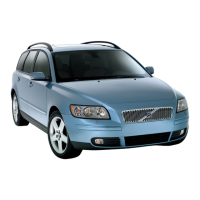120
Wheels and tyres
Driving characteristics and tyres
Tyres affect driving characteristics greatly.
Tyre type, size and tyre pressure are
important to how the car performs.
When replacing tyres, be sure to use the
same type, size and brand on all four wheels.
Otherwise the handling of the car could be
affected. Follow the recommended tyre
pressures stated on the decal on the fuel tank
filler cap.
List of dimensions
There is a size designation for all car tyres.
Example designation: 205/55R16 91 W.
205 Section width (mm)
55 Relationship between section height
and width (%)
R Radial tyre
16 Wheel rim diameter in inches (")
91 Code digits for maximum permissible
tyre load (in this case 615 kg (1355
lbs)
W The tyre is designed for speeds up to
240 or 270 km/h (150 or 170 mph).
General information
New tyres
Tyres are perishable
goods. They will begin to
harden after a few years
and their friction
properties will be
reduced. When
changing tyres always
try to get as fresh tyres
as possible. This is
particularly important for
Winter tyres. The week
and year of manufacture is indicated by 4
digits, for example 1502. The tyre shown in
the illustration were manufactured week 15,
2002.
Tyre age
Even if tyres have a theoretical service life of
up to ten years, it is recommended that tyres
older than six years are not used.
Tyres with tread wear indicators
Tread wear indicators are narrow, raised
areas located at right angles to the tread.
TWI is printed on the side of the tyre. When
a tyre is worn so that only 1.6 mm (0.06 inch)
of tread remains, the indicators will be clearly
visible. Replace with new tyres immediately.
Remember that tyres with little tread have
very poor grip in rain or snow.
Winter tyres
Volvo recommends winter tyres with a fixed
dimension. These are given on a decal on the
inside of the fuel filler flap. The tyre size is
dependent on the size of the engine. Always
use winter tyres on all four wheels.

